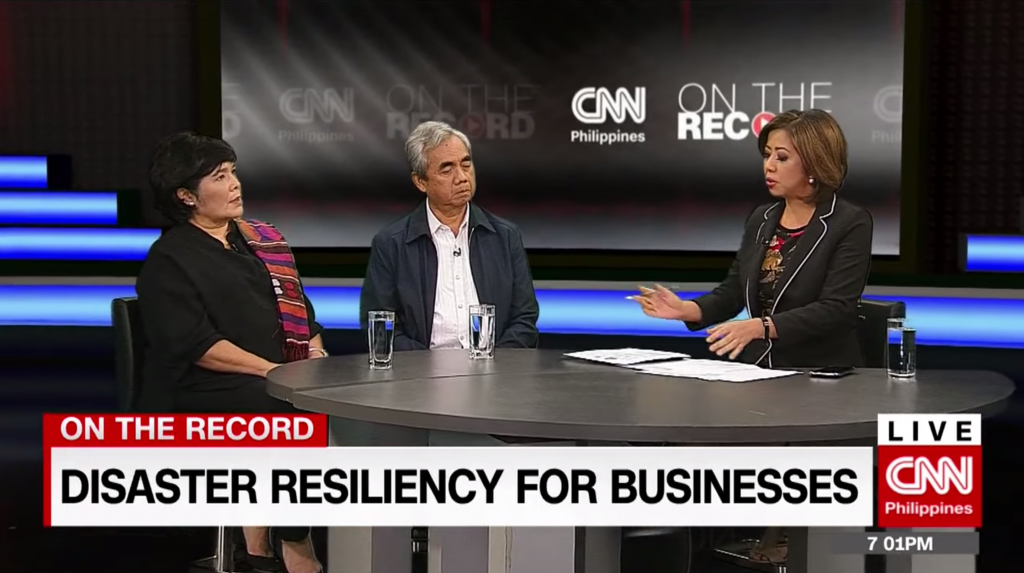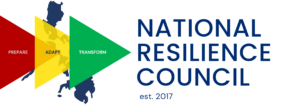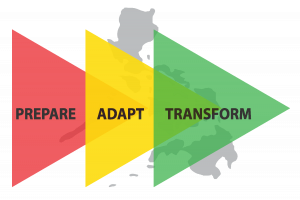In the News
Recent News

Small business owner? Here’s how to safeguard your enterprise in times of disaster
Metro Manila (CNN Philippines, November 21)— In light of the recent calamities—typhoons and earthquakes—that struck the country, the issue of disaster preparedness and resilience has once again been thrust into the spotlight.
Current rehabilitation programs, however, are mostly human-centric and focused on affected residents. There’s not a lot of attention for start-ups and micro, small and medium enterprises (MSMEs) which experts say are the “most vulnerable” in times of disasters.
“What happens to small businesses… the small businesses almost never recover. Unless they have something set aside for them to actually rely on in order to replenish their cash supply,” National Resilience Council President Toni Yulo-Loyzaga told CNN Philippines’ On The Record on Thursday.
So how can start-up entrepreneurs and MSME owners safeguard their businesses once calamity strikes?
Creating a continuity plan
One of the first steps business owners should take is the crafting of a business continuity plan. This involves creating a system to help prevent—and help companies recover from—potential threats brought by various external factors.
Yulo-Loyzaga said it is important to point out the perceived risks against a business.
“You need to have some sort of business (continuity) plan. For that, we need to anticipate what your risk is, we need to be prepared for the destruction that might occur,” Yulo-Loyzaga said.
“And this is usually linked to supplies– what are the products you can sell on a daily basis? Once those physical lines are interrupted, what is your option? These are the challenges the small and micro face,” she added.
Starting from the local level
In line with risk assessment, the National Resilience Council has also launched the Adopt-A-City program—a key initiative targeted to reduce local government units’ exposure and vulnerability to hazards.
“It’s a form of engaging the private sector into the process of building that resiliency,” Yulo-Loyzaga said of the program.
The campaign also includes lectures and trainings, which will help officials put a “baseline” on their current risk assessments.
“A resilient city must be able to bounce forward after a disaster– not just bounce back,” she added. “We have an assumption overall that we have existing exposure vulnerabilities. What we want is for the city to be able to prepare to recover, to absorb the disruption in a way that it will make it stronger in future risks.”
‘Resilience centers’ from private sectors
SM Prime Holdings has also launched its SM Reliance Center, which helps aid MSMEs in data storage and capacity building.
“We come up with the resilience center, wherein we provide our small and medium enterprises a certain amount of soft memory para (so) they can put in their critical documents in soft copies para ‘pag tinamaan (so if they’re hit by disasters), they can always have those documents that are necessary for them to be able to expedite getting their claims,” SM Disaster Risk Reduction Consultant Alex Pama said of the center, located at SM Clark in Pampanga.
Business owners can store essential documents such as permits, titles, and licenses in the center for free. This repository for documents is deemed essential for business continuity and recovery.
“These are the things that kung malasin man (if they get unlucky), at least they have soft copies. And this is free,” he told CNN Philippines.
SOURCE:
CNN Philippines. (2019, November 21). Small business owner? Here’s how to safeguard your enterprise in times of disaster. CNN Philippines. Retrieved from https://cnnphilippines.com/business/2019/11/21/how-to-safeguard-small-business-in-times-of-disaster.html
Recent News

PREPARE. ADAPT. TRANSFORM.
National Resilience Council
MOA Square, Seashell Lane cor.
Coral Way, Mall of Asia Complex, Brgy. 76
Zone 10, CBP 1A, 1300, Pasay City
Metro Manila, Philippines
Copyright ©️ 2024. National Resilience Council. All Rights Reserved.

